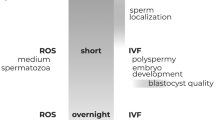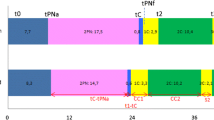Abstract
Purpose
A total of 86 fresh and salt-stored immature human oocytes derived from postmortem ovarian tissue were used for this study.
Methods
Oocytes were randomly incubated either in synthetic human tubal fluid medium (untreated zonae) or in a chemically defined medium (treated zonae).
Results
Sperm binding experiments using hemizona assay conditions exhibited a 10-fold increased binding of sperm to treated compared to untreated oocytes (272.7±43 versus 24.3±15 sperm bound, respectively; P<0.0001). pH recordings during incubation showed elevated pH levels of 8.1 compared to pH 7.2 among treated and untreated zonae, respectively. Ultrastructural examination showed a spongy appearance of the surface of treated zonae, whereas untreated zonae appeared compact with smooth surface.
Conclusions
The marked increase in sperm binding among treated zonae, together with the ultrastructural findings, suggest that the altered zona surface enhances sperm binding. The physiological maturational process of the zona pellucida might be manipulated in vitro, thus increasing sperm binding to the zona.
Similar content being viewed by others
References
Burkman LJ, Coddington CC, Franken DR, Kruger TF, Rosenwaks Z, Hodgen GD: The hemizona assay (HZA): development of a diagnostic test for the binding of human spermatozoa to the human hemizona pellucida to predict fertilization potential. Fertil Steril 1988;49:688–669
Liu CY, Lopata A, Johnston WIH, Baker HWG: A human sperm-zona pellucida binding test using oocytes that failed in vitro. Fertil Steril 1988;50:782–788
Wolf DP: The mammalian egg's block to polyspermy.In Fertilization and Fmbryonic Development in Vitro. L Mastroinni and JD Biggers (eds). Raven Press, New York. 1981, pp 183–197
Sathananthan AH, Trounson AO: Ultrastructure of cortical granule release and zona interaction in monospermc and polyspermic human ova fertilized in vitro. Gamete Res 1982;6:225–234
Swenson CE, Dunbar BS: Specificity of sperm-zona interaction. J Exp Zool 1982;219:97–104
Florman HM, Wassarman PM: O-linked oligosaccharides of mouse egg ZP3 account for its receptor activity. Cell 1985;41:313–324
Topfer-Petersen E, Mann K, Calvete J: Identification of porcine oocyte 55 kDa α and Β proteins within the zona pellucida glycoprotein families indicates that oocyte sperm receptor activity is associated with different zona pellucida proteins in different mammalian species. Biol Chem Hoppe-Seyler 1993;374:223–227
Tesarik J, Pilka L, Travnik P: Zona pellucida resistance to sperm penetration before the completion of human oocyte maturation. J Reprod Fertil 1988;83:483–495
Quinn P, Kerin JF, Warnes GM: Improved pregnancy rate in human in vitro fertilization with the use of a medium based on the composition of human tubal fluid. Fertil Steril 1985;44:493–498
Oehninger S, Veeck L, Franken D, Kruger TF, Acosta AA, Hodgen GD: Human preovulatory ooyctes have a higher sperm-binding ability than immature oocytes under hemizona assay conditions: evidence supporting the concept of “zona maturation.” Fertil Steril 1991;55:1165–1170
Familiari G, Nottola SA, Micara G, Aragona C, Motta PM: Is the sperm-binding capability of the zona pellucida linked to its surface structure? A scanning electron microscopic study of human in vitro fertilization. J in Vitro Fertil Embryo Transfer 1988;5:134–143
Phillips DM, Shalgi RM: Surface architecture of the mouse and hamster zona pellucida and oocyte. J Ultrastruct Res 1980;72:1–12
Tesarik J, Kopecný V: Late preovulatory synthesis of proteoglycans by human oocyte and cumulus cells and their secretion into the oocyte-cumulus-comple extracellular matrices. Histochem 1986;85:523–528
Edwards RG, Bavister BD, Steptoe PC: Early stages of fertilization in vitro of human oocytes matured in vitro. Nature Lond. 1969;221:632–635
Nishimoto T, Yamada I, Niwa K, Mori T, Nishimura T, Iritani A: Sperm penetration in vitro of human oocytes matured in a chemically defined medium. J Reprod Fert 1982;64:115–119
Veeck LL, Worthman JWE Jr, Witmyer J, Sandow BA, Acosta AA, Garcia JE, Jones GS, Jones HW Jr: Maturation and fertilization of morphologically immature human oocytes in a program of in vitro fertilization. Fertil Steril 1983;39:594–602
Lopata A, Leung PC: The fertilizability of human oocytes at different stages of meiotic maturation. Ann NY Acad Sci 1988;541:324
Veeck LL: Oocyte assessment and biological performance. Ann NY Acad Sci 1988;541:259
Author information
Authors and Affiliations
Rights and permissions
About this article
Cite this article
Henkel, R., Cooper, S., Kaskar, K. et al. Influence of elevated pH levels on structural and functional characteristics of the human zona pellucida: Functional morphological aspects. J Assist Reprod Genet 12, 644–649 (1995). https://doi.org/10.1007/BF02212590
Received:
Accepted:
Issue Date:
DOI: https://doi.org/10.1007/BF02212590




